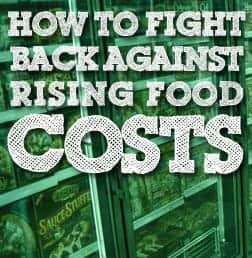Have you noticed a creep in your food prices? Do you go to the grocery store armed with a list and a careful budget only to find you go over budget or aren’t able to get everything on your list because of rising costs? If so, you’re not alone.
Our family has been spending what I think is a fair amount of money on groceries, but still, we are eating through our pantry. Simply put, our grocery money isn’t stretching as far as it used to. Are you noticing this too?
Kiplinger’s recently reported that grocery prices overall are expected to rise 4% in 2013. This is in large part thanks to the drought in the Midwest last summer. Not only are there fewer cows now because farmers sent many of them to slaughter when it became too expensive to feed them (making beef prices higher now), but chicken farmers are still having to pay higher grain prices, which directly increases the consumer’s price of both chicken and eggs.
If you’re looking to lower or just maintain your current grocery budget, there are steps that you can take that won’t reduce you to becoming a super couponer eating processed food for every meal. By making a few smart moves, you can continue to eat healthy, fresh food.
Strategies You Can Use Right Now
1. Buy in bulk.

2. Shop discount stores.
Stores like Aldi offer fresh fruits and vegetables and are even beginning to experiment with organic produce. Because you don’t pay for the experience to shop there (be prepared for most items to be shelved in the boxes they came in), you can save a significant amount of money.
Another option is to shop at a store like Costco or Sam’s Club. Just make sure you stick to your list and know what the best prices are. Not everything at a big box store is cheaper than at a grocery store.
3. Order online.
Amazon offers some excellent sales on products, so again, know your prices and keep an eye on Amazon. We are currently gluten free, but we were able to snag gluten free oats on Amazon at half the price I could find them in the grocery store.
4. Barter with friends.
If you have a surplus of an item that you found on sale, why not see if your neighbors, friends, or family want to barter with you? You may both be able to get some groceries you need without spending a penny in the exchange.
5. Eat lower cost foods.
Beans, ground meat, and certain vegetables are generally lower in price. Create meals and soups around low cost veggies like carrots, celery, potatoes and cabbage. Use meat as a garnish or as part of a soup or stew. Ground meat will be cheaper than steaks, for instance.
6. Find low cost recipes.
When trying to stretch your food dollars, you want to make meals that are cost efficient. You can browse Pinterest or follow bloggers such as the 5dollardinners.com, where each meal she features costs $5 or less.
Strategies to Save in the Upcoming Months
1. Plant a garden.
You don’t have to live in the country to benefit from a garden. We rent and can’t plant a garden in our yard, so we planted one in a community garden. This year we intend to plant two raised garden beds at the garden to increase our food production and savings. If you have a small porch or deck, you can plant vegetables in pots. You can also have an indoor herb garden.
2. Join a CSA.
CSA stands for community supported agriculture, and for 20 weeks, you’ll get vegetables and fruit straight from the farm at a steep discount. We joined two CSAs last year and paid about $45 a week. In return, we got an abundance of fresh vegetables. We had enough for eating fresh each week and for making freezer meals that we are still eating now, in February. A CSA is an excellent way to stretch your grocery dollar. (Go to localharvest.org to find a CSA in your area.)
If you are a couponer, you can certainly use coupons to lower your costs, but even if you aren’t, there are plenty of strategies you can use to help rein in the rising cost of groceries. There’s no need to resort to processed foods unless you want to. Eating fresh and healthy foods on a budget is still possible, even with rising food costs.
What are your favorite strategies for saving money when grocery shopping?


I have definitely noticed a hike in food prices over the last few years. Joining a CSA sounds smart. I bet most of the vegetables would taste way better than the ones from the store, too. I will look into doing that in our area. Thanks for the tips.
We’ve noticed the creep, too. We’ve adjusted by having a few vegetarian days a week. It’s amazing how the presence or absence of meat impacts the size of the grocery bill. The other thing is fresh veggies — it is a trade off, though: you put in more work chopping up, etc., but the cost definitely drops when you go from prepared to raw.
Good post, thanks!
For sure prices are rising! We have struggled to not spend more than our budgeted amount and so we shop sales. I have cut out some of the meals that cost more to make and made less costly dishes. So far we have managed to stay within our budget.
Good tips Melissa! We’ve noticed the creep as well and it just causes us to be smarter when making our purchases. We’ve cut back to shopping once every 10-11 days as opposed to once a week and that has helped quite a bit. We also garden a lot, so that helps as well.
I’ve definitely noticed the creep, but we’ve also been eating healthier and buying a lot more produce, so that’s increased my grocery budget as well. I buy the big staples (brown rice, etc) in bulk and eat from the pantry a lot, so that helps my family of five.
I’ve been afraid to try a CSA because it seems expensive where I live. I’m afraid we’ll end up tossing the vegetables that I don’t know how to cook or that no one else will try.
Gina–You might want to start with a smaller size CSA share. Last year we got the smallest sized one from two different farms. This year, we are narrowing down to one farm’s largest size. We loved their produce, and the things that don’t freeze well like eggplant, cucumbers and lettuce we’ll eat right away, and the things that do freeze well like spinach, peppers, etc., we’ll put in the freezer to use in the fall and winter. Hopefully that will help us save.
These are awesome tips. If you want to save, take the time to compare the prices. And when you buy in bulk, make sure that they are not perishable as well. I also like the idea of a garden. It’s more organic and maybe it would be fun to plant those vegetables.